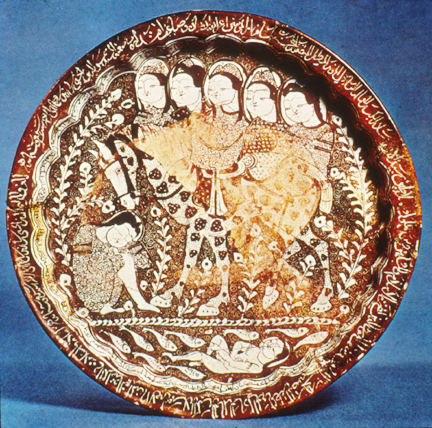Another Islamic proscription forbad the use of precious metals such as gold and silver for the making of vessels. This conversely opened up another market to the potter, as gold and silver lustered ceramic vessels did not fall under this ban. The range of color available with luster is from ruby red, to shades of brown, to chartreuse, and lemon. Luster was used on plates, bowls, ewers, and tile, and is a decorative technique that is purely of Middle Eastern origin, and not Chinese. Kashan lusterware is superior in quality to all others and often features delicately drawn and crowded scenes such as this one, with humans depicted as having round faces and long eyes. Textiles are rendered in dense pattern, and every square inch of surface area is decorated. Here, the central image is bordered by a frieze of Kufic script. At left a sleeping prince on a beach is attended by 5 young maidens atop a decorated horse. The prince sleeps next to a river or pool filled with fish and another sleeping figure. Note that in Kashan lusterware the figure is 'reserved,' meaning not painted. The white of the figures is the white fritware clay body. Variations in color of the luster are due to patination, showing the effects of time on the fragile luster surface. As mentioned earlier, the proscription against figurative work was not absolute, and was ignored in some areas of the Islamic world. Mongol invasions of the 1200's did not seem to harm Kashan, as its luster production continued until 1400 CE.
This example is indicative of lusterware of Kashan during the Middle Islamic period, and is signed by its painter, Sayyid Shams al-Din al-Hasani.

Fritware Plate from Kashan, Luster, 1210 CE


